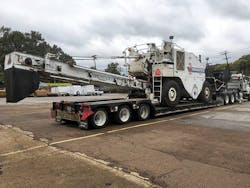The tank transporter is a piece of military hardware that you will never see in a war movie, but it made mechanized warfare since World War II possible. With its low body design and sturdy, rigid steel frame work, the tank transporter consisted of a front truck cab hooked to a rear trailer. Tanks would drive themselves onto the trailer via attached ramps and get hauled long distances. Despite its fearsome reputation on the battlefield, the tank is actually quite fragile when forced to travel long distances on its own, especially its treads, chassis, sprockets, and drive train. And so, the tank transporter vehicle was invented for long-distance hauling of armored fighting vehicles.
The same principles apply to the civilian world of heavy construction equipment. Many of these are in the same weight class as tanks, move on tractor treads, and require considerable maintenance under normal circumstances and serious repair if subject to overly harsh operating conditions. Like tanks, heavy construction equipment relies on hauling trailers whose design and construction are based on combat models used over half
a century ago.
The Assigned Task—Matching the Trailer with the Equipment to be Hauled
The first step is to generate the specifications for the equipment being carried. These include overall equipment dimensions (length, wheel base, tread width, cab height, etc.) and weight. With this information, a properly sized hauling trailer can be assigned to the task of hauling the equipment. Existing trailers can be modified, or specific trailers specially built to haul the equipment. Typically, the trailer is designed around the dimensions and operating weight of the equipment. Usually, existing hauling trailer models are sufficient to haul all but the most specialized pieces of heavy equipment.
The actual structural members that are brought together to form the trailer’s frame utilize many different thicknesses, cross-sectional designs, length, connection welds and rivets, and materials. Steel is preferred for high strength frames but results in a weight penalty. Aluminum frames are the opposite, saving in weight but often not providing the strength necessary for heavy-duty applications. As form follows function, these design factors depend on the project use of the trailer and what kind of equipment it will be hauling. Like the design of a skyscraper’s steel frame, it all comes down to a three-way tradeoff between weight, strength, and cost.
However, there are limits to the size and weight of equipment that can be hauled on highways and state roads, and these limits indirectly define the maximum strength and weight requirements of the hauling trailers. Weight limits are defined by axle loadings and the damage they inflict on pavement and roadway subgrades.
Knowledge of these weight limitations and the regulations behind them is critical to achieve the most cost-effective trailer design. As Patrick Jennissen, VP of Sales and Marketing for Felling Trailers, notes: “We want to make the entire trailer buying process as easy as we can for both our dealers and their customers. We’re happy to work directly with the end-user on our dealer’s behalf to assist in configuring the trailer per their specific needs/requests. Large trailers can be very intimidating, especially because of the state and federal regulations that come into play with trailers hauling dimensionally large and heavy equipment. In addition to state and federal regulations, hauling trailer manufacturers will ensure product quality by adhering to the strict standards of ISO 9001-2015 certified. And they will guarantee that quality with full coverage warranties (Limited Lifetime Structural & 3 Year Paint being the preferred standard).
The Loads They Carry
What kind of equipment is hauled by an equipment trailer? The answer is: all kinds, especially if they are serviced by tractor treads. For example, a review of the Caterpillar Performance Handbook’s section on track-type tractors gives an extremely wide range of operating weights and track gauge widths. Their smallest dozer, the D3C, has an operating weight of 15,518 pounds and a track gauge width of 4 feet, 8 inches. Their largest dozer, the D11R, has an operating weight of 225,500 pounds and a track gauge width of 8 feet, 4 inches. In between are 40 different model types, each with its own track gauge width and operating weight. So, there can be no “one size fits all” solution for hauling heavy equipment.
Instead, picking the best trailer is a process of matching the dimensions and strength of the trailer to the dimensions and weight of the equipment. And as the saying goes, “nothing is more expensive than being cheap.” A lot is riding (literally) on the equipment trailer, and skimping on its requirements is the very definition of “penny wise and pound foolish.” In general, flatbed trailers are used to haul smaller pieces of equipment. Step deck trailers are utilized for the hauling of medium-sized equipment. The large and very large pieces of equipment need removable goose neck (RGN) trailers. Smaller trailers are less expensive to buy and to use with step deck trailers and AGRN trailers being increasingly expensive.
Standard heavy equipment comes in three broad categories: construction loaders, earth moving equipment, and earth digging equipment.
The type of trailer required is a function of both the size and type of the equipment.
Certain types of equipment, no matter their operating weight, tend to be lengthy or tall. Graders and scrapers are hauled almost exclusively by RGN trailers. Articulated dump trucks are both lengthy and tall, requiring the use of RGN trailers. Excavators have a tall operator’s cab and a lengthy excavator arm, so they too are moved on RGN trailers. These equipment types usually also incur a wide load designation.
Structural Design and Suspensions—Strength and Flexibility
It’s not just the weight of the equipment that is being hauled that determines the required structural strength of the hauling trailer. Of almost equal importance is the nature of the roads (or even dirt pathways) that the trailer is being driven over. This includes equipment weight, the internal concern, and environmental conditions (road roughness, potholes and gullies, slippery or icy conditions, how evenly the equipment is loaded versus the steepness of the roadway, etc.). A well-designed and built hauling trailer has to withstand the impact loads of a dozen different environments over thousands of round trips. The actual fitting together of the trailer’s structural components determines the trailer’s overall strength just as much as the structural components themselves. These components can be joined together with either welds or bolts, directly or with gusset plates, etc.
The structural analysis that goes into the arrangement of the various members and components of the hauler trailer is essentially no different than that of a bridge or skyscraper. By determining the bending moments, compressive forces, and tensile strains induced into each member by the applied dead load of the heavy equipment (and secondarily the self-weight loads of each member), the appropriate size and cross-sectional area of each member can be determined that will resist these forces with an internal strength that provides a necessary factor of safety against collapsing or bending. Over the years, several basic design configurations have been developed:
- Flatbed Trailers have the simplest designs with a single flat deck extending the full length of the trailer and having an adjustable ramp attachment in the rear to allow the equipment to drive itself onto the trailer so it can be secured for transport.
- Drop Deck Trailers have the main deck that supports the heavy equipment in a lowered section in the middle of the trailer between the front and rear wheels. This is a design for medium-sized equipment with the lowered mid-section allowing for taller equipment while avoiding the oversized load designation. These also have adjustable ramps attached to the rear end of the trailer.
- Hydraulic Dumps, or “Dump Boxes,” come in various sizes. This is a flexible design that allows an operator to haul either a small load of dirt or a small piece of equipment.
- Deck-Over Tilts are designed for easy loading and off-loading of equipment without the need for ramps, improving both productivity and safety.
- Semi-Trailer Lines are used to haul heavier loads and utilize both ramps and hydraulic lifts mechanisms.
The design of the trailer’s suspension system, like the design of the trailer itself, is a function of the anticipated equipment loads. Matching the suspension rating with the anticipated load is a function of simply adding the anticipated axle loads (for example, a pair of axles each carrying 20,000 pounds would have a suspension capable of supporting 40,000 pounds).
After considering the anticipated load weights, the suspension design must consider the types of surfaces that the trailer will be riding on. An off-road trailer designed for movement across rugged and irregular terrain will be different than an over-the-road trailer intended for travel on roadway pavements. A trailer designed for mountainous conditions with steep inclines and slopes will again differ from a trailer that is used for transport across level terrain. In any case, suspensions should be chosen that will align the wheels and axles for straight pulling and without undue wear and tear on wheels, alignment, and axles.
Major Suppliers
Felling Trailers is a family-owned and operated Full Line Trailer Manufacturer located in Central Minnesota. Started in 1974, Felling Trailers Inc. has grown from a small shop to a factory and office complex that today covers over 325,000 square feet. Felling’s pride and differentiation is its customized trailer division. Its engineers utilize the latest industry-leading design techniques, and its experienced metal craftspeople use cutting-edge technology to turn its customers’ conceptual trailer needs into a tangible product. Felling has been providing innovative trailer solutions to the transportation industry for over 45 years. Felling Trailers’ current capabilities allow them to provide a high-quality product that is distributed across North America and internationally. Felling Trailers Inc. is an ISO 9001:2015 Certified Quality Management System company and a WBENC-Certified WBE Company. Their diverse Construction Trailers product line includes trailers ranging from the smaller side such as their 3,000-pound Light Utility Trailers to the larger side such as their 120,000-pound Heavy Haul Application Trailers. They have trailers sized to carry equipment as small as lawnmowers to larger equipment such as skid-steers, backhoes, and pavers. Felling’s OTR Series (Over the Road) trailers provide service as long-distance commercial carriers. These are premium quality trailers specifically designed to meet the demands of the commercial, over-the-road driver with superior quality and performance. Their capacities range from 35 tons to 50 tons.
Interstate Trailers Inc. offers trailers with unique structural design elements that are rated at carrying capacity, removing all guesswork as to the trailers’ strength characteristics. Pierced Main Beams allow for use of deeper main rails and crossmembers while maintaining a lower deck height. Piercing also creates a unitized, inter-locking frame for added strength. Cold Formed “A” Frame ensures that main-rails are not compromised by cutting notches to form drawbar angles. Modular wiring housed in PVC jacketed harness is modular in design so that wiring damage is repairable by simple modular replacement. Their specialized Hutch 9700 Suspensions equalize distributed load weight evenly to axles, while their 44,800-pound total spring capacity on dual tandems prevents complete spring deflection under extreme load.
The same diversity is shown in their model lines. Tagalong RBS Series Trailers have an 83-inch load width and range in capacity from 6-ton to 9-ton with Dexter torflex axles standard throughout. Interstate’s BST Series single-tire deck over trailers range from 6- ton to 9-ton capacity and utilize 12-inch man rails and oak decking. Their BST/S models are designed for the transport of directional boring machines and similar. Capacities range from 6 tons to 10 tons. DT/DTA trailers are available in 9- to 12-ton capacities with Hutch 9700 suspensions and 6-inch I-beam crossmembers standard on most models (including RGN trailers). Their DLA Series includes 20-ton two axle and 25-ton three axle versions with optional Air Lift axle and Air or Hydraulic ramps available. The smaller TST tilt trailers are built like their larger models but are used to haul machines in the 5-ton to 8-ton range. Medium duty TDT/TDA trailers are available in 10-ton or 12-ton capacities and are equipped with a 4-foot stationary deck, and are also able to haul backhoes and similar equipment. Specialized APC trailers are specifically designed with the paving contractor and his equipment with low incline ramps and roller deck option allowing for easier loading. Their hydraulic TDL tilt trailers are available in 15-ton to 25-ton capacity and come equipped with dual tilt cylinders, a standard 4-foot stationary deck, and an air operated bed lock.
At the larger end of the scale are Interstate’s Goosenecks and Lowboys. Fixed neck lowboys are available from 25 to 50 tons. Operational versatility is provided by optional full width gentle slope neck and extended air or hydraulic ramps. PHT Powertail trailers are available in 35–50 tons and come standard with a 12K winch, 14-degree load angle air ride suspension, and 35-inch loaded deck height. Detachable neck lowboys are available from 35-ton to 60-ton capacity with four beam constructions; apitong decking and air ride suspension come standard. The air lift 3rd axle and 13 hp Honda powerpack are optional.
Manac Trailers provides heavy-haul trailers under the Manac, Liddell Canada, Scona, and Peerless brands, which are designed to carry maximum payload and provide the operator the highest possible return on his or her investment. These trailers are often custom-designed and built to meet a wide range of specialized operational and jurisdictional requirements. The trailers are designed using high-strength steels (up to 130 KSI steel) in order to minimize tare weight while maximizing toughness and durability. Many components and even complete frames are galvanized to improve corrosion resistance. Lowbed models offer mechanically or hydraulically detachable goosenecks and interchangeable deck platforms. They employ air ride or rugged mechanical walking beam style suspension systems. Configurations are modular and include compatible deck extensions that can be mixed and matched to provide the required deck length and weight distribution for a wide variety of loads. Models are available from 35-ton to 85-ton load capacity and ride on 17-inch to 24.5-inch wheels. Many larger capacity lowbed combinations require a load-divider jeep between the tractor and semi-trailer and a load-divider booster dolly at the rear of the trailer to add more axles to the road. When a heavy haul combination reaches 13 axles, it is often referred to as a Super Hauler and requires special permits to operate. The Super Hauling combinations can also employ self-steer and steerable axle groups in order to navigate roadways. These heavy-haul trailers are designed for “on-off” road operation, meaning that a large portion of their operating time is mostly spent in extremely harsh environments: construction sites, forestry roads, oilfield leases, mine sites, sand dunes, and ice roads. Manac offers heavy haul trailers for the Construction, Forestry Road Building, Oil and Gas, Energy, Mining, and Agricultural markets.







